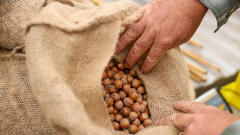Dan and JoAnn Keeley’s farming operation outside St. Paul, Oregon, had a banner year in 2014.
The same year Dan retired from his job as a civil engineer for Marion County, the farm had a huge harvest: more than 150,000 pounds from its 50 acres of hazelnut trees.
Hazelnuts were at record prices that year. They were able to pay off the mortgage on the farm and put cash in the bank for a rainy day.
Eight years later, it’s not raining, but it’s not a good time for hazelnut farmers, either.
Oregon is expected to produce a record amount of hazelnuts this year. But that won’t mean record incomes – farmers will be fortunate to break even.
The Hazelnut Growers Bargaining Association negotiates the guaranteed price farmers in Oregon will receive. In a memo to farmers just before the harvest, it said the minimum price per pound is 40 cents to 53 cents, depending on the variety.
It is the lowest price since the early 2000s, and about half what they got a year ago and about a quarter of the high of $1.70 in 2014.
“The price here is terrible. The price elsewhere (in the world) is equally as bad or worse,” said Terry Ross, executive director of the bargaining association.
Why are hazelnuts going for such a low price this year? It’s complicated.
Hazelnut identity tied with Oregon
Oregon produces about 99% of the hazelnuts grown in the United States, but only 6% of the worldwide supply.
Hazelnuts – also known as filberts, or Tukwila, the name in Chinook – have been grown in the state since 1858, according to multiple sources. Nearly all Oregon hazelnut farms are in the Willamette Valley. Most are in Marion, Polk, Yamhill and Linn counties. The weather in the valley in areas like St. Paul and Aurora is optimal for hazelnut growing.
Hazelnuts became Oregon’s state nut in 1989. Find any hazelnut-centric cookbook and it was probably written and published in Oregon.
It’s a nut politicians use to make a point, as Gov. Kate Brown did in 2017 when she forgave a boy for swiping a hazelnut and a pen during a tour of the State Capitol. When things go bad for the hazelnut industry, as they did in 2019, politicians are quick to provide emergency monetary assistance for the farmers.
The state’s hazelnut harvest was worth $132 million in 2020. That was the 10th highest value in dollars among agricultural commodities produced in Oregon, according to the USDA’s National Agriculture Statistics Service.
In the 1990s and 2000s, hazelnut orchards were impacted by “blight,” a fungus that grows on hazelnut trees and decimated orchards.
Oregon State University developed several new varieties of trees that were less susceptible to the disease. That gave the industry a boost. Farmers could plant new trees in fields formerly occupied by crops like grass seed and corn with little fear of them being wiped out.
The state has 95,000 acres of hazelnut trees, or about the size of all Oregon state parks combined. That’s three times what it had eight years ago.
But it takes four years for hazelnut trees to produce nuts, and they don’t produce high yields until the sixth or seventh year.
Hazelnut trees don’t have to be watered. But many farmers choose to water – and add fertilizer – to produce more nuts.
The state produced a record 63,000 tons of hazelnuts in 2020, according to the National Agriculture Statistics Service and was projected to produce 80,000 tons this year, according to Ross.
With more trees coming into production – or full production – in the next few years, the number of hazelnuts the state produces should continue to increase.
A longtime hazelnut farmer has seen the ups and downs
The Keeley family purchased their farm in the early 1980s. In the early 1990s, they had three children and decided they needed more money to send them to college. Their farm mostly grew grass seed, and they saw they had an opportunity to make more money with some hazelnuts.
They planted about 5,000 trees on about 50 acres. They still had 300 acres of grass seed and other crops.
“We were making more on the 50 acres of the hazel crops,” Dan Keeley said.
At the peak in about 2016, their trees produced about 200,000 pounds per year.
The Keeleys sell some of their hazelnuts to a co-op and some to a private corporation.





